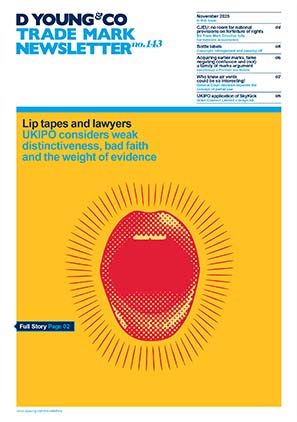Protecting visual aspects of video games - how about a design registration or a registered trade mark?
When it comes to protecting visual aspects of a video game in the UK and other parts of Europe, such as the EU, quite rightly one of the primary forms of protection that springs to mind is copyright. This is as it should be, noting copyright pertaining to a visual aspect of a game can automatically manifest itself as soon as the visual aspect is first recorded/devised, thus making the protection easy to obtain. Copyright protection is also fairly lengthy in terms of duration, noting it can last in excess of 70 years in a number of European territories. That being said, there are additional forms of registered intellectual property protection which can be particularly powerful in protecting visual aspects of a video game, and which can sit very nicely alongside copyright. Such protection includes registered designs, and also registered trade marks.
UK and EU registered designs
At least in the UK and many parts of Europe, such as the EU, a design registration can cover a variety of different visual aspects relating to a video game, such as the appearance of protagonists from the game; the appearance of a level; the design of a HUD, or other GUI which the player interacts with; or even objects/power-ups/pick-ups which a player might be expected to use as part of the game.
Unlike with enforcing copyright, one of the primary benefits of enforcing a UK or EU design registration is that it is not necessary to demonstrate that any competitor design “copied” the relevant design in question.
To obtain a UK or EU design registration, it is necessary to apply for such protection as part of a formal application submitted to the relevant design registry where protection is required (the UKIPO for the UK, or the EUIPO for the EU). Obtaining a valid UK or EU design registration also preferably requires the application to made before the underlying design is publically disclosed. Appreciably, both the UK and the EU provide a grace period of twelve months, which allows the intended owner of a UK or EU design registration to defer applying for such protection by up to twelve months from when the owner first discloses the underlying design publically. However, there are a number of practical reasons why relying on such grace period provisions in the UK or EU should be avoided, where possible.
Another positive of UK or EU registered design protection is the speed of obtaining this protection. In this respect, once a UK or EU registered design application is submitted, it can take as little as a week or so to be allowed/registered, assuming there are no objections with the application.
It is also worth noting that the UK and EU registered design regimes allow multiple designs to be pursued in a single application very cost effectively. So in the context of video games, this could practically mean any such application could have a first design directed to, for example, the appearance of protagonist of a game; a second design perhaps directed to the layout of a level from the game; with perhaps a third design directed to the appearance of a GUI from the game. It can therefore be seen that UK or EU registered design protection can allow for very different facets of a game to be simultaneously protected very cost effectively.
Once registered, a UK or EU design registration is provided with an initial term of protection which lasts five years. It is then possible to extend this protection, at the end of this five-year period, by paying a renewal fee to extend the protection for a further five-year period. This process can then be repeated every five years, as required, to allow for a maximum term of protection of 25 years. At the end of this 25-year period, the UK or EU design registration then finally lapses. For a number of video games, this period of protection is enough to span the commercial lifetime of the game.
UK or EU registered trade marks
The holy grail of protecting a visual aspect of a video game is through the use of a registered trade mark, to the extent one can obtain such protection.
In comparison with obtaining a UK or EU design registration, it is possible to apply for a UK/EU trade mark relating to a visual aspect of a video game at any point in the lifecycle of the video game, even if this is some time after the game has been publically disclosed.
This often happens in practice since UK or EU trade mark protection is only available if the trade mark (the visual aspect of the game one is seeking to protect) is capable of acting as a badge of origin, such that people would associate this visual aspect to a particular owner or brand (this is the essential function of a trade mark). Effectively, this relates to the requirement that a UK or EU trade mark must have “distinctive character” in respect of the particular goods and services in relation to which the UK or EU trade mark protection is being sought (noting that UK or EU trade mark protection requires specification of such goods and services), in order to be capable of registration.
Although distinctive character may be inherent in, for example, an image of a specific character at the beginning of a video game lifecycle, if distinctive character is not immediately inherent for a visual aspect of a game, UK or EU trade mark protection may nonetheless be a possibility later on, if it can be subsequently shown that distinctive character has been acquired through use in the relevant UK or EU marketplace, by virtue of the visual aspect becoming exclusively associated with the particular owner by the relevant consumers. Specifically, as the prevalence of a game starts to manifest itself, and its players start to associate visual aspects of the game with the game itself, this is the point when UK or EU trade mark protection for visual aspects which may otherwise be said to lack the requisite inherent distinctive character initially, starts to come into play.
Noting UK or EU trade mark protection can be slightly more involved to obtain than UK or EU design registration protection, not least because of the distinctive character requirement, it is to be noted in compensation that UK or EU registered trade mark protection has the potential to last much longer than a UK or EU design registration. In that respect, any registered UK or EU trade mark lasts for an initial period of ten years, which can then be extended by a further period of ten years through payment of a renewal fee. This process can then be repeated, every ten years as required, to allow for a potentially unlimited duration for the UK or EU trade mark, as long as the mark continues to be used in a commercial context (once a UK or EU trade mark has been registered for five years it can be vulnerable to revocation filed by third parties if not used in relation to all goods or services). Accordingly, if there is a video game protagonist whose appearance is expected to last for a very long time, across multiple games for many decades, the appeal of a UK or EU trade mark covering the appearance of this protagonist is clear.
In addition to the duration of protection, one of the main advantages of securing UK or EU trade mark protection in respect of a visual aspect of a game, as compared with UK or EU design registration protection, is that a UK or EU trade mark has greater potential for being enforced against a competitor using a visual aspect which is “confusingly” similar to the visual aspect protected under the trade mark registration. This can often provide a bit more latitude or flexibility (arguably more so than with a UK or EU design registration) to be able to enforce rights against a competitor game taking the gist, spirit or concept of a particular protected visual aspect, even if the competitor’s variant shows some notable visual differences.
Additionally, some UK or EU trade marks develop a reputation over time, and any such trade mark also has the potential to be enforced against third party activity which might be argued as damaging the reputation of the trade mark (or be detrimental to its distinctive character), even if this third party usage is in respect of goods or services which are not similar to those for which the trade mark is registered. For an image of a video game protagonist protected under a UK or EU trade mark, the potential to clamp down on third party activity which might be construed as damaging the reputation of this protagonist (as a trade mark), can make trade mark protection very desirable.
In summary, a registered UK or EU trade mark can be more difficult, and often more expensive, to initially obtain than a UK or EU design registration. However, a UK or EU trade mark registration compensates for this in so far as it can serve as a more potent and versatile tool at the enforcement stage, particularly in the longer term. This should not detract from the appeal of UK or EU design registration protection however, which itself has the principal advantage of allowing multiple visual aspects from a video game to be protected much more cost effectively compared with UK or EU trade mark protection, and does not have the requirement for distinctive character.
Official fees
An important observation in the context of UK or EU trade mark protection is that each mark requires its own application, which can increase the official fees for obtaining this protection, particularly where protection is sought for multiple visual facets of a game at the same time. Specifically, the official application fees to attempt to secure protection for a number of visual aspects from a game, using either a UK or EU registered design application, and/or using UK or EU trade mark applications, start from as shown in the table below:
| Number of visual aspects to be protected | UK registered designs (£) | EU registered designs (EUR) | UK trade marks (£) | EU trade marks (EUR) |
|---|---|---|---|---|
| 1 | 50 | 350 | 170 | 850 |
| 3 | 70 | 700 | 510* | 2,550 |
| 5 | 70 | 1,050 | 850* | 4,250 |
| 10 | 70 | 1,925 | 1,700 | 8,500 |
| 20 | 90 | 2,725 | 3,400 | 17,000 |
* It is possible in some limited instances to pursue up to six marks of extremely similar appearance in a single UK trade mark application, as a “series mark”, at reduced official fees than those quoted above. Otherwise however, protecting different visual aspects of a video game individually requires a separate UK trade mark application (and thus separate official fees) for each different visual aspect.
That being said, although trade mark protection may be more costly to obtain in the short term, it has the potential to act as a much more potent form of protection, particularly in the longer term, after any design registrations may have expired.
Conclusion
There is no “right” answer as to how best to protect visual aspects of a video game using intellectual property protection in the UK or EU. Copyright is of course a powerful tool in its own right, but the opportunity for supplemental protection using either UK or EU registered designs, or UK or EU trade marks (or both), is something which should always be contemplated.
If UK or EU design registration protection is of interest, it is preferable to apply for this protection before disclosing the underlying game in any way, noting the opportunity for such protection falls away if the visual aspects have been publically disclosed too long before any such protection is sought.
To the extent UK or EU trade mark protection is of interest for a visual aspect from a game, again it can be worth applying for this protection sooner rather than later. However, and depending on the visual aspect in question, it may be necessary to defer applying for such trade mark protection until such time when it can be demonstrated that distinctive character has been acquired in the visual aspect concerned.


